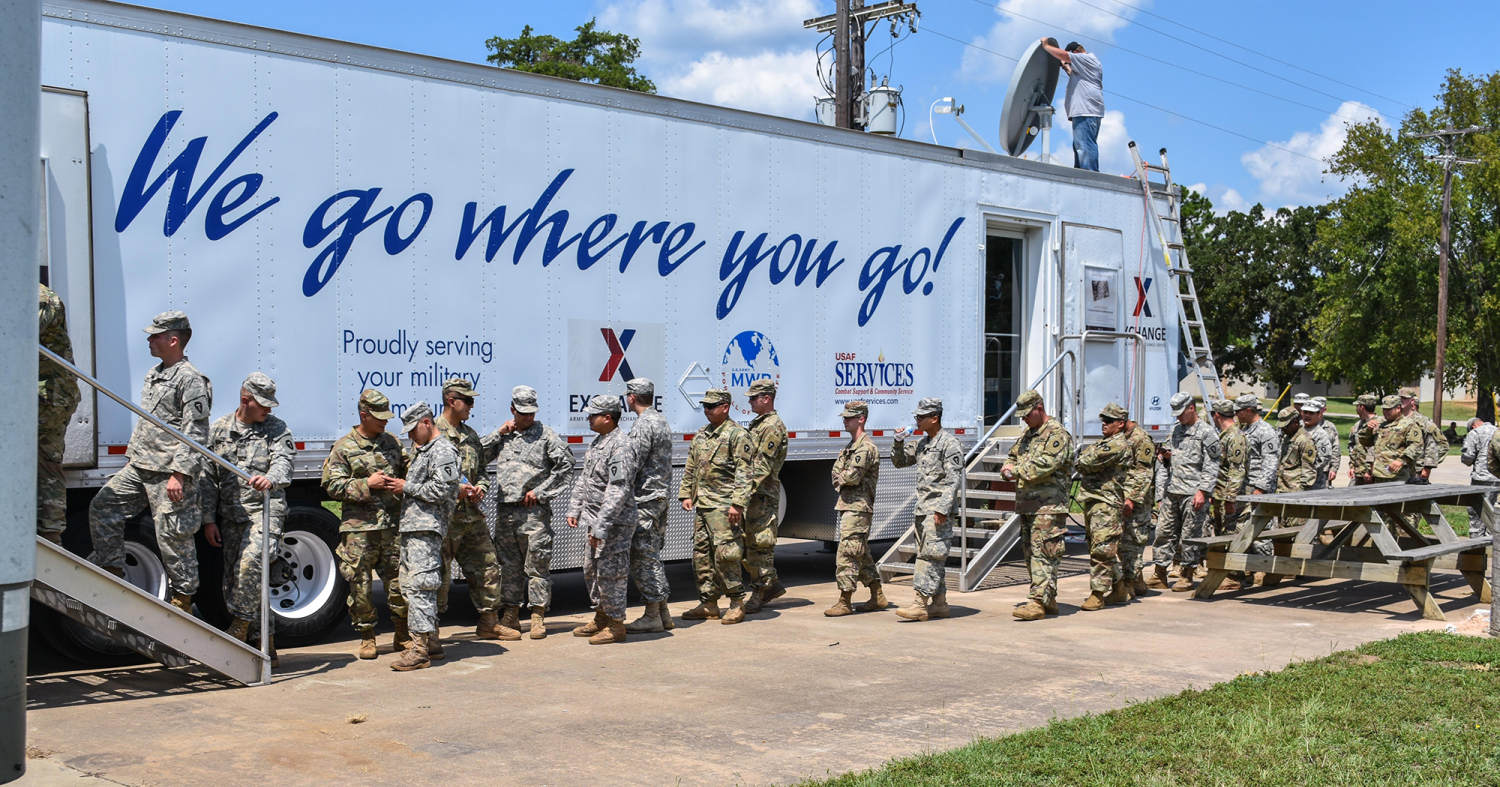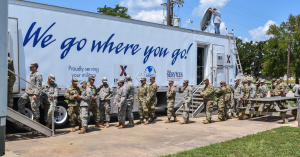#FlashbackFriday: Tracking MFEs Through Exchange History

Due to their high demand in assisting with Operation Allies Welcome (OAW), mobile field exchanges, known as MFEs, have received a lot of attention recently. In mid-September, all but two of the Exchange’s 11 U.S.-based MFEs were in active service, with seven of them helping installations provide essential support to at-risk Afghan guests while they complete the necessary steps for resettlement in the United States.

A mobile field exchange served National Guard members deployed to Bastrop, Texas, for Hurricane Harvey relief efforts in 2017.
The OAW support is just one example of the variety of MFE responses during Exchange history.
Although Exchanges had mobile elements before World War II, MFEs began to become more common during the war. In May 1942, three 2½-ton trucks were sent to Iceland, where they were adapted for selling hot foods and drinks, and then put into operation in July to serve troops defending the island against Hitler’s forces.
When troop levels were reduced, one of the units was sold to the Icelandic government, one was used as a general-service truck and one was given to the Red Cross, which served coffee and doughnuts from it. MFEs were deployed throughout the war.
During the Korean War, mobile exchanges were one of the solutions to the problem of serving troops in isolated areas and in locations where a stationary exchange was not feasible. Portable prefabricated buildings and even vending machines were also used for this purpose.
The mobile exchanges took different forms, ranging from a C-47 Air Force PX to a two-car PX train used by a military police battalion to 10 2½-ton trucks at Pusan Depot. As battlefield operations slowed down in Korea, mobile exchanges became more common. In October 1952, 18 converted buses were assigned to forward areas of the Eighth Army. Some buses were part of “Operation Reindeer” and were equipped with items troops could send back home as Christmas presents.
During Operation Desert Shield, exchange managers at Forts Bragg, Campbell and Stewart prepared mobile units for shipment to Saudi Arabia, where they served as exchange stores or warehouses. A mobile unit from the Hunter Army Airfield Exchange in Savannah, Ga., met troop ships at the Georgia Port Authority, with Fort Benning sending two trucks in support. Bergstrom Air Force Base in Austin, Texas, turned a U-Haul truck into a mobile exchange, with merchandise from the main store and military clothing store.
In 1994, the Malmstrom Air Force Base Exchange equipped a 40-foot trailer to support troops from Fort Hood and firefighters battling a fire near Missoula in western Montana. The Mountain Home AFB Exchange in Idaho sent a 24-foot truck to support Soldiers, National Guard members and firefighters in western Idaho. The Fairfield AFB Exchange equipped a 40-foot truck and two vans to support firefighting efforts in central Washington, with help from Fort Lewis-McChord associates.
In the aftermath of 9/11, Exchanges in New York and in the Washington, D.C., area set up mobile field exchanges to support search-and-rescue efforts at the sites of the World Trade Center and Pentagon attacks.
MFEs were also used during hurricanes, including Katrina in 2005 and Ike in 2008; during the 2010 Haiti earthquake; during Superstorm Sandy in 2012; and in support of recovery efforts after other natural disasters. They also serve those who serve at the tip of the spear: In 2019, associates opened three MFEs in Poland over the course of nine days to support the 1st Armored Brigade Combat Team and the 1st Combat Aviation Brigade of the 1st Infantry Division from Fort Riley, Kan., as they conducted training exercises for U.S. Army Europe Operation Atlantic Resolve in support of NATO.
During the COVID-19 pandemic, eight associates from the Fort Hamilton and West Point Exchanges volunteered to run an MFE in New York City, at the time the epicenter of the pandemic. The MFE, which was requested April 1, 2020, was sent from the Waco Distribution Center the next day. Exchange driver Eddie Hill picked it up at Fort Dix and drove it to New York City, where it opened at the Army’s field hospital at the Javits Center to support the 3rd Expeditionary Sustainment Command Soldiers, National Guard members and civilian medical personnel.
An MFE was also sent to Fort Benning, where 500 Soldiers who had recently completed basic training were unable to continue to their next assignment because of COVID-related travel restrictions. The soldiers were housed in a remote part of the installation. Associates from the main Exchange staffed the MFE. At Fort Drum, an MFE served quarantined troops who were not permitted to leave a controlled area and could not shop at the installation’s Exchange facilities.
MFEs typically carry a standard assortment of snacks, beverages and hygiene items geared toward active-duty troops, but the ones supporting OAW have been stocked with Afghan guests and their families in mind. Items not typically found in MFEs, such as diapers, have been part of the stock.
In addition to OAW support, current MFEs are supporting Operation Atlantic Resolve in Poland and Lithuania and ongoing service for coalition forces at Al Udeid Air Base in Qatar. In late September, the Exchange Post reported that two more were being prepped for deployment to the Torun and Drawsko Pomorskie Training Areas in Poland. More are being planned for the 2022 military exercise cycle in Europe.
Sources: One Hundred Years of Service: A History of the Army and Air Force Exchange Service, 1895-1995; Exchange Post archives

